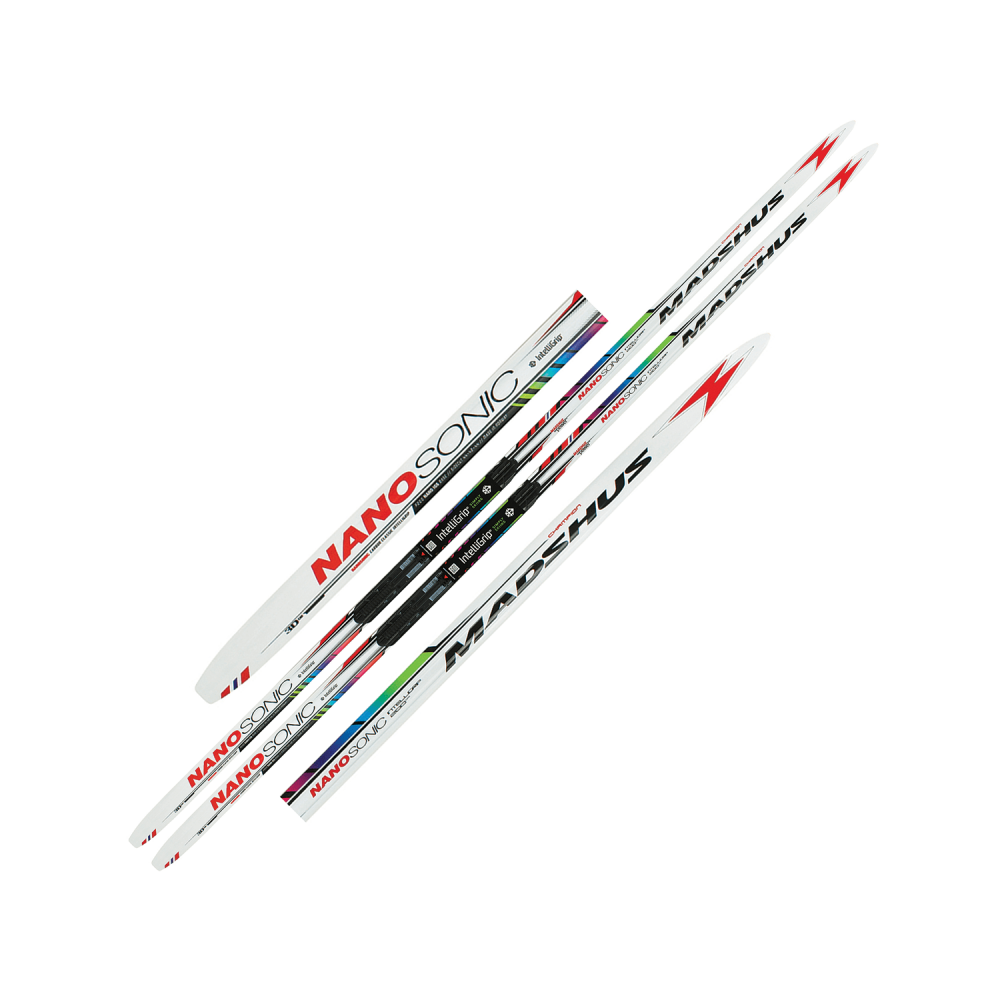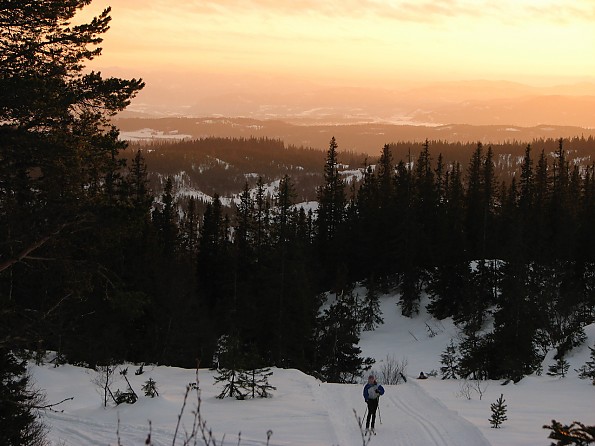Madshus Nanosonic IntelliGrip
The Nanosonic IntelliGrip has been discontinued. It was replaced by the Madshus Endurace IntelliGrip.

A mid-to high performance waxless ski for skiing in groomed tracks. Performs nearly as well as a waxed ski in most conditions, but can be a bit slow for experts in softer tracks.
Pros
- Waxless convenience in all conditions
- Little compromise on performance
- Expert level ski
- Replaceable skins
Cons
- A bit slow in softer conditions
- In-track only
For multi-modal skiers like myself there has always been room in the quiver for a couple pairs of waxless skis. Various waxless technologies have come and gone over the years, and I have tried some of the main variations, including a “chemical” waxless base produced by Karhu and a few others back in the '80s. Textured “fishcale” bases have hung in there all along, and are nice to have in variable conditions where one wax won’t do the job, or to avoid the sticky unpleasantness of klister. But even the best “racing” textured bases can be slow in soft tracks, and annoyingly noisy on hard snow. On good tracks in consistent snow, give me a waxed—or kilstered—ski every time.
At least until the arrival of the latest waxless technology, “skin skis”—skis with one or two strips of mohair in the kick zone. These have exploded in the Norwegian market, and I assume elsewhere, for the good reason that they perform well enough in variable conditions to satisfy even expert skiers and are a great choice for wax-avoiders as well. In fact, one of my reasons for reviewing these skis here on TS is to alert some of the more casual skiers in the community about this excellent new alternative to waxed skis. Readers can take many of the thoughts in this review as applying to skin skis in general, not just the Nanosonics.
Hopping on the bandwagon, my wife and I bought a pair of Nanosonics each when they showed up on sale at the start of last season. I’m a big fan of Madshus xc skis (even though Fischer still dominates on the race circuit). My first pair of xc skis ever was a pair of the original Madhus Birkebeiner, all wood with a natural wood finish. I loved those skis literally to death, put God knows how many kilometers on them during my college years, did my first tele turns on them and finally broke them a few months into my life as a telemark skier.
The more modern Madshus skis that I have owned, including the updated Birkbeiner, have always had what I call a silky glide, maybe because they are a little softer up near the tip than some of my other skis. For the last decade or so, I have had a hard time keeping track of all the different models—there have been Hypersonics, Ultrasonics, Nanosonics, and Terrasonics, and sometimes I haven’t been sure which one of those was the top of the line at any one time.
The Nanosonics are an entry level racing ski or a high level “marka” ski. Although the 44-42-44 mm profile suggest a hint of side cut, they are too skinny for out-of-track skiing, barring the occasional short cut through real snow. As of 2019-20, Madshus has abandoned the -sonic naming system. The equivalent ski in the new lineup seems to be the Active Intelligrip.
Madshus’ name for its skin technology is “Intelligrip”. (Whenever I see that word on the back of my skis I can’t help but think of the hilarious “Intellivator” pranks by the Norwegian comedy team Ylvis of “What Does the Fox Say?” fame—if you haven’t seen them I suggest you drop everything right now and give the brothers a few minutes of your valuable time).
I’m not sure it’s really all that intelligent, being just a short strip of attractive blue mohair embedded in the ski base under the binding and spanning most of the width of the ski. Like removable climbing skins on backcountry skis, the fine hairs point backwards to bite into the snow for a forward kick but offer little resistance as the ski glides forward. The skis’ wax pocket helps keep the mohair out of contact with the snow during the glide phase. Some other skin skis have dual strips on either side of a groove down the middle of the ski.
Skin ski technology isn’t really new—I recall trying out a pair much like that way back in the '70s, in sticky snow conditions that started sticking to the mohair as soon as the skis hit the snow. But perhaps the skin material has improved. Madshus uses a mix of Mohair and nylon, and I have experienced no icing over the first season of use in a wide variety of conditions. We bought a skin care kit that includes a cleaner and a treatment solution that perhaps prevent icing.
The skins can be replaced using a heat gun to melt the glue under the skin. This looks like a delicate enough operation that I’d rather have the shop do it. After a season of use the skins show little sign of wear, so I expect they’ll hold out for at least a season or two more. For more casual skiers, they should last a lifetime.
Binding choice
On the advice of our salesman, we paired our new skis with Rottefella Move bindings, which allows the user to slide the binding forward or backward over a range of about 3 cm to get better kick or glide depending on conditions. Unlike a wax job, the skin doesn’t adjust to different conditions and the binding is supposed to make up for that inflexibility. As with pretty much all modern Nordic skis, the binding slides and locks onto a plate that is permanently affixed to the ski. No jigs, drilling, or screws necessary, so binding mounting is a 5-minute process, but still usually done by the shop.
The mounting plate technology alone allows finicky users to side the binding fore or aft to adjust for conditions with the help of a little key. Rottefella just took it a step further by allowing on-the-fly adjustment via the red dial on the front of the binding. In our case, the shop sold us last year’s model ski with a mounting plate that was a little too short for the new binding. We discovered the problem when one of my wife’s bindings started sliding around. The shop was rightfully embarrassed about the incompatibility and gave both of us new skis.
I put in 60-70 km on these skis over a few days around Christmastime 2018, all on groomed trails in the city forest areas here in Trondheim or during a few days’ stay near the ski town of Oppdal in the Trollheimen mountains during Christmas week 2018, mainly in well-groomed tracks. It only took a few km to note that these skis kick and glide as well as a waxed ski in hard-packed, dry-snow tracks. But after a few km in softer, freshly set tracks in new snow they began feel a bit slow. I haven’t tracked use very precisely, but I probably put in another 300-400 km on these skis over the course of the season, all in-track, in conditions ranging from cold, dry snow to full-on spring klister conditions.
The Nanosonics have an expert skier’s stiff, high wax pocket and require good technique to get a kick in hard tracks, but the mohair sticks out just enough to drag in softer snow, more than a waxed ski would in the same conditions. Basically, the softer the snow, the slower you go—but in mist conditions still probably fast enough for most skiers. So, skin skis, or the Nanosonics at least, are not the One Ski To Rule Them All, but their performance in hard tracks is good enough that I found myself using them regularly throughout the rest of the season rather than taking the time to wax before heading out.
I’ve never been a waxing fanatic, but I don’t mind spending 30 minutes to an hour in the basement prepping skis for a good day of skiing. Having said that, I’m also very happy to grab a pair of skis with yesterday’s wax on them, maybe touch them up a bit on the front porch, and head out. The skin skis allow me to skip even the touching up part; less waxing time = more skiing time. This is not to say that they never need waxing. All ski bases need at least occasional hot waxing as a part of routine maintenance, or they become “dry” (for example, white streaks or regions on black bases) and slow. For me that might mean fresh, ironed-in glide wax every 50 km or so—a half hour job, less per pair of skis if I do multiple pairs.
As I write this, on December 1, 2019, we’re getting our first good snow of the season here in Trondheim, Norway. Usually, excellent trail grooming is provided by the city using our tax kroner. The lighted trails in one of the city forest areas pass within 100 meters of our door. Unfortunately, it looks like we will get warmer temperatures and rain in a few days, so the city is saving its grooming budget for later in the season. I’ll be heading out on backcountry skis for my afternoon ski and that’s just fine. But I also look forward to some fast day and evening tours out the back door, and as often as not I’ll probably be choosing the convenience of the Nanosonics.
Background
I am an expert nordic skier with nearly 50 years of experience. I xc ski 1000 to 1500 km in a typical season. I used these skis over an estimated 400-500 km in a wide variety of conditions during the 2018-19 ski season.
Source: bought it new
Price Paid: NOK 3000, on sale with Move bindings included








